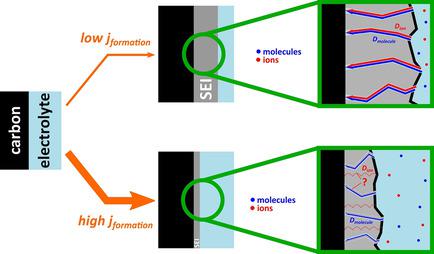当前位置:
X-MOL 学术
›
Batteries Supercaps
›
论文详情
Our official English website, www.x-mol.net, welcomes your
feedback! (Note: you will need to create a separate account there.)
Influence of the Formation Current Density on the Transport Properties of Galvanostatically Formed Model‐Type Solid Electrolyte Interphases
Batteries & Supercaps ( IF 5.1 ) Pub Date : 2019-10-04 , DOI: 10.1002/batt.201900110 Sebastian Kranz 1 , Tobias Kranz 1 , Tim Graubner 1 , Yuriy Yusim 1 , Lukas Hellweg 1 , Bernhard Roling 1
Batteries & Supercaps ( IF 5.1 ) Pub Date : 2019-10-04 , DOI: 10.1002/batt.201900110 Sebastian Kranz 1 , Tobias Kranz 1 , Tim Graubner 1 , Yuriy Yusim 1 , Lukas Hellweg 1 , Bernhard Roling 1
Affiliation

|
During the production of commercial lithium‐ion batteries, the solid electrolyte interphase (SEI) on the graphite particles of the negative electrode is typically formed through galvanostatic protocols with low current densities. Consequently, SEI formation is a time‐consuming and rather expensive production step. In order to better understand the influence of the formation current density on the transport of ions and molecules across the SEI, we formed model‐type SEIs on planar glassy carbon electrodes under galvanostatic control. In accordance with the expectations from electrochemical nucleation and growth theory, we find that the transport of both ions and molecule becomes slower with increasing formation current density. However, it is remarkable that the ion transport is slowed down more strongly than the molecule transport. We show that at high formation current densities of about −71 μA cm−2, our model‐type SEIs clearly exceed the area‐specific resistance tolerable in commercial lithium‐ion cells.
中文翻译:

形成电流密度对恒电流形成的模型型固体电解质中间相输运性质的影响
在生产锂离子电池的过程中,负极石墨颗粒上的固体电解质中间相(SEI)通常是通过恒电流协议以低电流密度形成的。因此,SEI的形成是一个耗时且相当昂贵的生产步骤。为了更好地了解形成电流密度对离子和分子跨SEI传输的影响,我们在恒电流控制下在平面玻璃碳电极上形成了模型型SEI。根据电化学成核和生长理论的期望,我们发现离子和分子的传输随着形成电流密度的增加而变慢。但是,值得注意的是,离子传输的速度比分子传输的速度要慢得多。−2,我们的模型型SEI明显超过了商用锂离子电池所能忍受的特定区域电阻。
更新日期:2019-10-10
中文翻译:

形成电流密度对恒电流形成的模型型固体电解质中间相输运性质的影响
在生产锂离子电池的过程中,负极石墨颗粒上的固体电解质中间相(SEI)通常是通过恒电流协议以低电流密度形成的。因此,SEI的形成是一个耗时且相当昂贵的生产步骤。为了更好地了解形成电流密度对离子和分子跨SEI传输的影响,我们在恒电流控制下在平面玻璃碳电极上形成了模型型SEI。根据电化学成核和生长理论的期望,我们发现离子和分子的传输随着形成电流密度的增加而变慢。但是,值得注意的是,离子传输的速度比分子传输的速度要慢得多。−2,我们的模型型SEI明显超过了商用锂离子电池所能忍受的特定区域电阻。










































 京公网安备 11010802027423号
京公网安备 11010802027423号